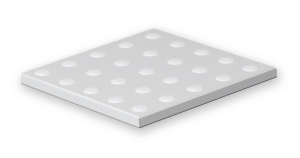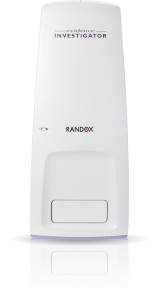Acute Kidney Injury
Acute Kidney Injury
Multiplex Detection of Acute Kidney Injury from a Single Sample
Acute kidney injury (AKI) is currently diagnosed using serum creatinine as recommended by the KDIGO guidelines. Serum creatinine however, has poor sensitivity and specificity for AKI lagging behind both renal injury and recovery. There is an immediate need for more sensitive biomarkers to enables earlier identification of AKI, monitor drug toxicity and identify patients at an increased risk of CKD, end-stage renal disease or long-term kidney dialysis.
The National Institute for Health and Care Excellence (NICE) has highlighted that is important that patients are assessed for AKI on admission to hospital or transfer, monitored for AKI throughout their stay and AKI is managed appropriately if it develops.
Utilising patented Biochip Technology, the Randox Acute Kidney Injury (AKI) array simultaneously tests for four novel biomarkers delivering early diagnosis and monitoring of treatment efficacy It may also help you conduct safer and faster clinical trials.

Randox Acute Kidney Injury (AKI) Array (4-plex)
This marker is highly upregulated in kidney tubule cells following nephrotoxic injury severe enough to result in acute renal failure, acute tubular necrosis or acute tubulo-interstitial nephropathy.
Due to its small size and basic pH, Cystatin C is freely filtered by the glomerulus. It is then reabsorbed by tubular epithelial cells and subsequently metabolized. Accumulation of Cystatin C in urine is specific for tubular kidney damage and suggests reduced reabsorption at the proximal tubules as a result of toxicant-induced kidney injury.
Expression of Clusterin is upregulated following a variety of renal injuries and is detectable in urine following acute kidney injury induced by administration of nephrotoxic agents. This occurs before the profound renal transformations that give rise to changes in creatinine and BUN.
KIM-1 is a 30kDa type 1 transmembrane glycoprotein found on actvated CD4+ T cells. It is undetectable in healthy kidney tissue but is expressed at very high levels in proximal tubule epithelial cells in the kidney after toxic injury.
The Evidence Investigator
Meet the Evidence Investigator
The Randox AKI array has been developed for the Evidence Investigator, a semi-automated benchtop immunoassay analyser.
The AKI array would improve patient risk stratification whilst monitoring the effectiveness of treatments & drug toxicity by simultaneously and quantitatively detecting multiple urine biomarkers of kidney damage-related analytes from a single sample.

Want to know more?
Contact us or visit our Investigator Webpage
Randox Reagents celebrate World Kidney Day 2017
On 9 March 2017, Randox Reagents are celebrating World Kidney Day! World Kidney Day is a global campaign aimed at raising awareness of the importance of our kidneys to our overall health. It aims to reduce the frequency and impact of kidney disease and its associated health problems worldwide.
This year, the World Kidney Day promotes education on the harmful consequences of obesity and its association with kidney disease, advocating healthy lifestyle and health policy measures that make preventive behaviours an affordable option.
With this in mind, throughout the week we have been sharing on social media some interesting facts on diagnostic tests which can help aid an early risk assessment of kidney disease in obese patients, allowing preventative action to be taken before any serious damage occurs. The tests of focus this week included cystatin C, adiponectin and microalbumin…
Cystatin C
The creatinine test is routinely run for patients who are suspected for deteriorating kidney function, however this test has limitations. Cystatin C is an alternative test, and is particularly useful in patients where creatinine measurements are not suitable e.g. individuals who are obese, malnourished, have liver cirrhosis or reduced muscle mass. Importantly, unlike creatinine, cystatin C does not have a ‘blind area’ – up to 50% of kidney function can be lost before significant creatinine elevation occurs. Cystatin C is extremely sensitive to very small changes in kidney function and is therefore capable of detecting early stage kidney dysfunction. The cystatin C test therefore allows preventative measures to be taken much earlier and before significant kidney function decline.

Adiponectin
There is substantial evidence that excess visceral fat is the main driving force for almost all of the disorders associated with the metabolic syndrome, including CKD.1,2 The adiponectin test from Randox can accurately assess levels of abdominal visceral fat, independent of age, race or fitness level.3,4 Assessing adiponectin, and therefore visceral fat levels, can help assess risk of CKD, as well as a range of other illnesses such as pre-diabetes, CVD and various cancers.
Microalbumin
The microalbumin test detects very low levels of a blood protein called albumin, in urine. The detection of albumin in urine can be an indicator of kidney injury and can result in irreversible damage if left untreated. Low albumin concentrations in the urine are the earliest marker of kidney damage and therefore enable preventative measures to be taken. Microalbumin testing can identify individuals with diabetic nephropathy approximately 5-10 years earlier than proteinuria tests helping reduce the frequency of end stage renal disease.
Both World Kidney Day and Randox are working towards improving healthcare worldwide. With continuous investment in R&D, Randox are helping with the risk assessment and earliest detection of renal function problems. By assessing one’s risk of kidney problems (with the adiponectin test), it can give patients (obese and other) the tools to prevent kidney problems further on down the line. With early diagnosis (through the cystatin C and microalbumin tests) it will be possible to keep kidney problems from getting worse, therefore lowering the number of those diagnosed with CKD worldwide.

